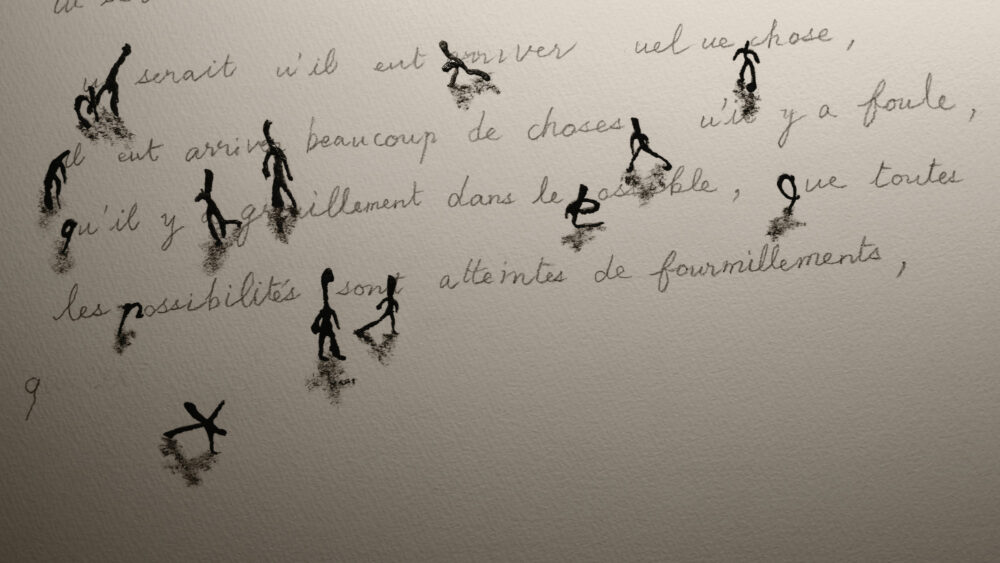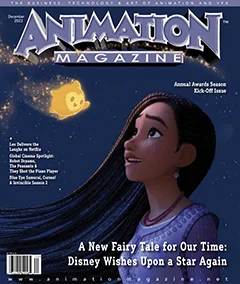|
Getting your Trinity Audio player ready...
|
Ryo Orikasa, whose latest work, Miserable Miracle, won the top animated short prize at the Ottawa International Animation Festival in September, first became interested in the works of Henri Michaux (1899-1984) back when he was in his early 20s and picked up a copy of the French Belgian poet and artist’s work at a used bookstore in Tokyo.
“I remember reading the poem Dog’s Life at the beginning of the book,” Orikasa recalls in an email interview. “Later, I found out Michaux’s complete works were published in Japan before they were published in France, and all the texts were translated by one person: Eiji Kokai, a poet who’s also known for translating André Bazin’s What Is Cinema?”
Years later, Michaux’s work would come alive through animation in Orikasa’s acclaimed short, which is a joint venture between Miyu Productions, National Film Board of Canada and New Deer with the support of France’s CNC and the Ciclic Animation Residency. Narrated memorably by Tony Robinow, the 2D-animated short casts a light on the limits of language and perception, and seamlessly weaves a hypnotic trance as it connects sounds, meanings, shapes and motion.
Orikasa says it’s difficult to explain what originally inspired him. “I believe that one’s motive for a project is something that’s discovered or invented later, but it had caught my attention that Michaux frequently wrote about the relationship between his drawing lines and film,” says the director. “Then I learned that he had attempted to produce a film.”
The 37-year-old director’s thought-provoking short began to take shape when he participated in a residency at the Fontevraud Abbey, organized by NEF Animation in France in the fall of 2018. He later worked in Ibaraki, Japan; Saumur and Paris, France; and Tokyo, changing production locations every six months or a year.
“At a studio in Saumur (Ciclic) and the one in Tokyo, I worked with the staff for six months each,” he recalls. “In total, 17 people participated in the project, including myself and two or three other people working at the same time. The production lasted four-and-a-halfyears, though the original plan was for two years; it was extended due to the huge amount of work and technical challenges that were all new to me.”
‘I love the moments in which I can immerse myself in creation … moments when I, as the creator, serve the words, which act as master. Certain words become a stimulus and the image expands beyond the original conception.’
— Director Ryo Orikasa
When the NFB decided to join the production, it was decided to produce an English-dubbed version of the film. “They also suggested that Tony Robinow would be the best person to do the voice work,” says Orikasa. “I was very grateful for the suggestion, as I have always found subtitles to be a source of stress for viewers in my films where the written word appears. His calm but strong voice has a different appeal than the original French version by Denis Lavant, and as a result I have two films on my hands, not a different version of one film. Now we’re planning to make a Japanese-dubbed version for the 2024 release in Japan.”

Paper Work
One of the major challenges for the director was that most of the short’s shots are uninterrupted, and the imagery changes slowly at times. “This made communication with multiple crew members difficult in terms of sharing the final image,” he explains. “I constantly struggled to quantify and communicate my intent by preparing diagrams and graphs. I also always traveled with a lot of paper, which was another tough aspect of the production process.”
Of course, there were ample rewards in the process itself. “I love the moments in which I can immerse myself in creation,” he recalls. “Moments when I, as the creator, serve the words, which act as master. Certain words become a stimulus, and the image expands beyond the original conception, and I, myself, am forced to follow the image, which never stops moving.”
When asked about his animation heroes, Orikasa says he has learned a lot from Jan Švankmajer, Kōji Yamamura and Pierre Hébert. “Also, the work of André Lindon (director of The Invisible Child, 1984) makes me want to keep making films, even if no one sees them.”
The director says Miserable Miracle has taught him an important lesson in keeping a limited view or portrait of an artist in your head. “The danger in referring to the work of a particular artist is that it risks fixing the image of that artist and limiting it within the confines of a particular culture,” he notes. “For example, as of September 2023, there is still no catalogue raisonné [descriptive catalog of an artist’s work] of Henri Michaux’s entire oeuvre, and every day in galleries and online auctions I continue to encounter a Michaux I do not yet know. I would be happy if animation provided another way of discovering a different facet of Michaux.”
For more information, visit nfb.ca/film/miserable-miracle and miyu.fr/production/en/emergences-2.


















